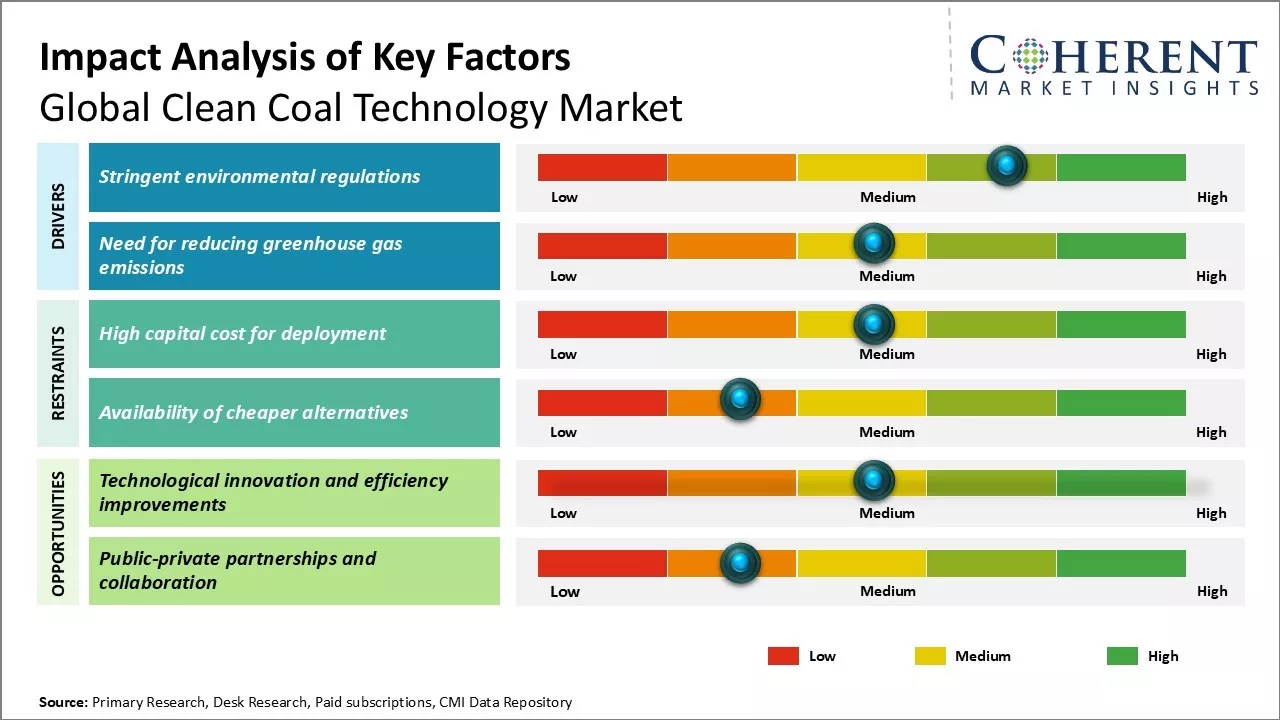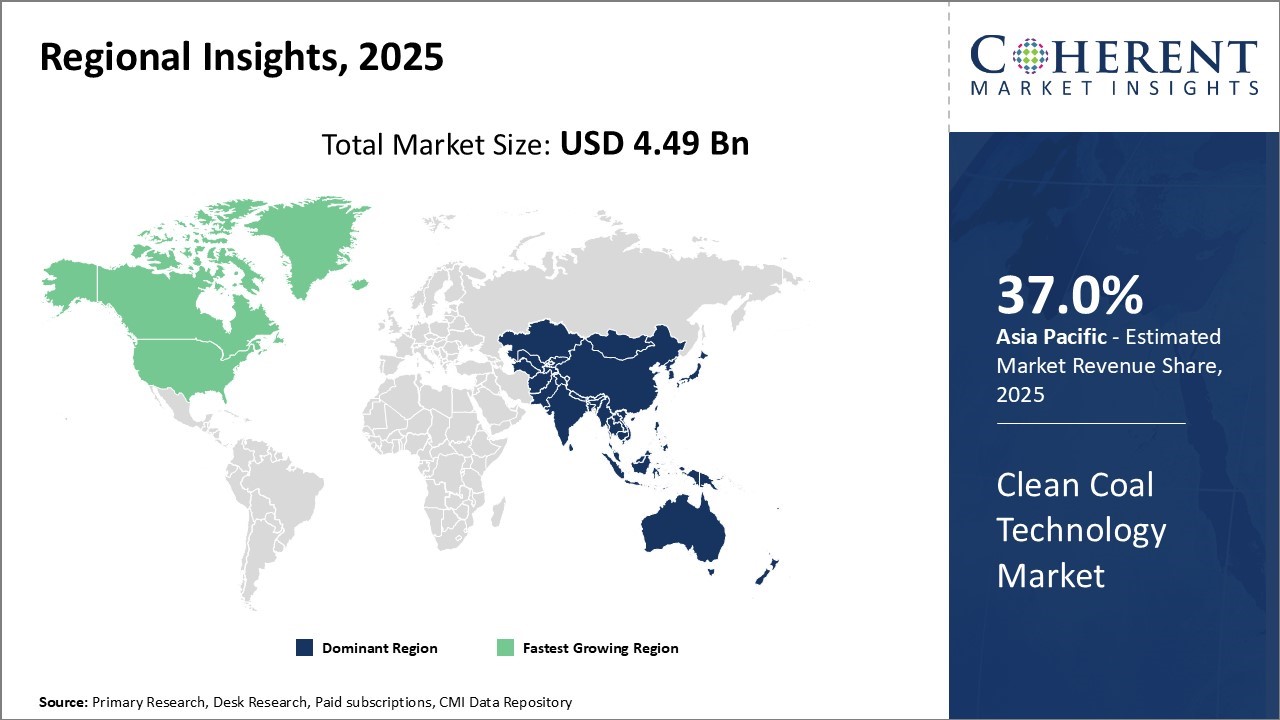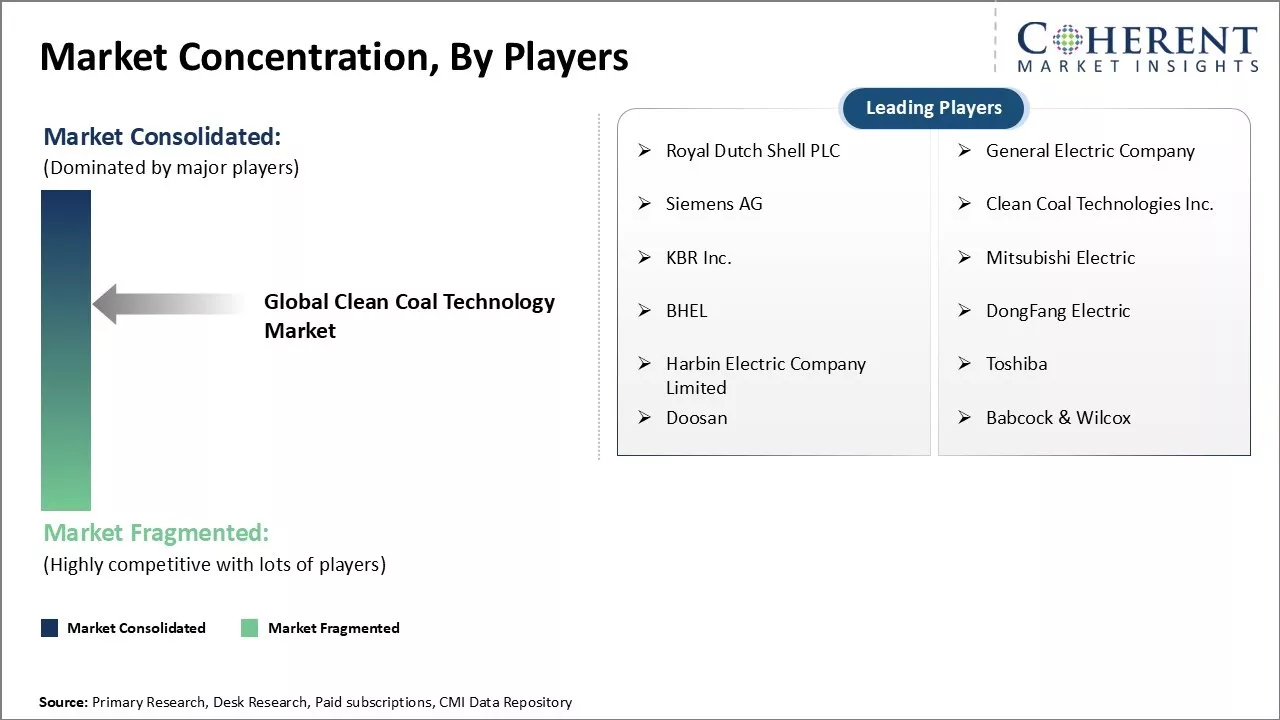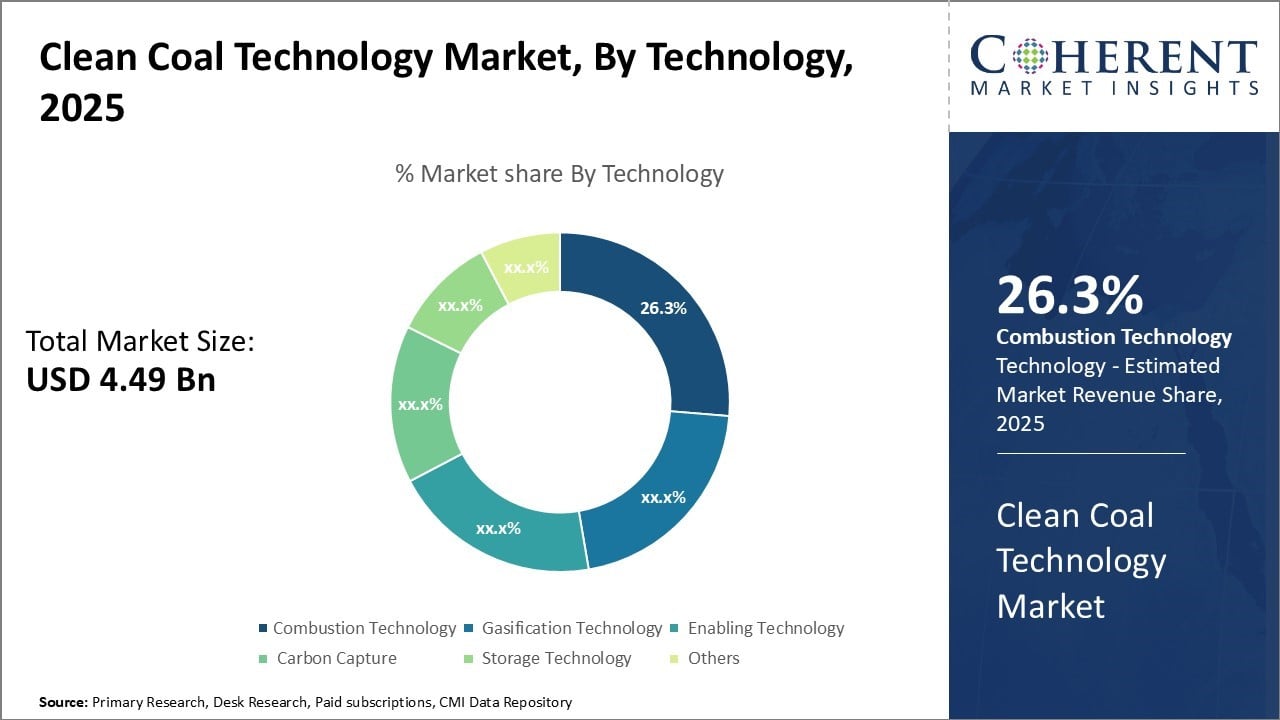Clean Coal Technology Market Size And Share Analysis - Growth Trends And Forecasts (2025-2032)
Global clean coal technology market is estimated to be valued at USD 4.49 Bn in 2025 and is expected to reach USD 6.71 Bn by 2032, exhibiting a compound annual growth rate (CAGR) of 5.9% from 2025 to 2032.

To learn more about this report, Download Free Sample
Key Takeaways
- By Technology, the combustion technology segment is projected to account for 26.3% of the global clean coal technology market in 2025, driven by continuous innovations aimed at enhancing energy efficiency and reducing harmful emissions.
- By Application, the power generation segment is expected to dominate the clean coal technology market with a 28% share in 2025.
- Asia Pacific is projected to lead the global clean coal technology market with an estimated 37.0% share in 2025, fuelled by rapid industrialization and energy demand across nations such as China, India, and Indonesia.
Market Overview
The global Clean Coal Technology Market is witnessing steady growth, driven by rising energy demand, environmental concerns, and the need for cleaner fossil fuel alternatives. Technologies such as advanced combustion systems and carbon capture solutions are gaining traction for their ability to reduce emissions while enhancing efficiency. Power generation remains the primary application, supported by ongoing infrastructure modernization.
Current Events and its Impact on the Clean Coal Technology Market
|
Current Event |
Description and its impact |
|
Global Push for Carbon Neutrality |
|
|
Policy Support for Low-Emission Technologies |
|
|
Asia Pacific’s Shift Toward Cleaner Energy |
|
Uncover macros and micros vetted on 75+ parameters: Get instant access to report
Clean Coal Technology Market Trends
- Stringent environmental regulations
With the ever-increasing concerns about climate change and its impacts, environmental regulations across major economies have been tightened significantly over the past decade. Coal has come under intense scrutiny as one of the top contributors to air pollution and greenhouse gas emissions. The large-scale usage of coal for power generation was creating numerous environmental issues including rise in emissions levels.
Many developing nations were still heavily dependent on coal to meet their growing energy needs. However, stringent laws regarding emission norms made it imperative for utilities to reduce pollution arising from coal combustion.
In May 2025, the Times of India reported that West Bengal’s Deocha Pachami coal block will implement clean coal gasification technology using underground coal gasification for 30% of its reserves. This move is part of the state’s strategy to harness sustainable energy solutions and support green hydrogen and renewable manufacturing initiatives.
Challenges in the Clean Coal Technology Market
- High capital cost for deployment
High capital costs involved in deploying these technologies has been restraining the market growth. Establishing carbon capture, usage, and storage (CCUS) systems, along with pollution control equipment, requires substantial initial investments. For example, implementing carbon capture in a 500 MW coal-fired plant can cost between USD 400 million and USD 1 billion, depending on site-specific factors. These high costs reduce incentives for power producers to adopt clean coal solutions and discourage new entrants into the market.
Clean Coal Technology Market Oppotunities
- Technological innovation and efficiency improvements
Technological innovation and ongoing efficiency advancements present significant growth opportunities in this market. The International Energy Agency (IEA) is actively conducting extensive research to enhance and reduce the costs of carbon capture, utilization, and storage (CCUS) technologies. Cutting-edge methods, such as chemical and biological approaches to CO₂ removal, aim to improve capture efficiency while driving down expenses.
Similarly, the development of advanced supercritical and ultra-supercritical power plants, equipped with state-of-the-art efficiency-boosting technologies, enables reduced coal consumption and lower emissions per unit of energy generated.
Global Clean Coal Technology Market Insights, By Technology
The combustion technology segment is projected to account for 26.3% of the global clean coal technology market in 2025, driven by continuous innovations aimed at enhancing energy efficiency and reducing harmful emissions. Advanced systems such as fluidized bed combustion and integrated gasification combined cycle (IGCC) are gaining widespread adoption due to their ability to optimize coal utilization while minimizing pollutants like sulphur dioxide and nitrogen oxides.
These technologies align with global climate targets, enabling countries to continue using coal as a transitional fuel while reducing its environmental footprint. Their increasing deployment in both developed and emerging economies reflects a strategic shift toward modernizing coal-fired infrastructure with lower-emission solutions.
Global Clean Coal Technology Market Insights, By Application
The power generation segment is expected to dominate the clean coal technology market with a 28% share in 2025, underscoring coal’s ongoing importance in fulfilling global electricity needs. As nations seek to balance energy reliability with sustainability, clean coal technologies are being widely adopted to modernize existing power plants and ensure compliance with stricter emissions regulations.
Technologies such as carbon capture, high-efficiency combustion, and pollution control systems are enabling more efficient and cleaner energy production. With electricity demand rising, particularly in developing regions, the integration of clean coal solutions into national grids has become a priority for energy planners and utility companies aiming to achieve energy security and environmental goals.
Regional Insights

To learn more about this report, Download Free Sample
Asia Pacific Clean Coal Technology Market Trends and Analysis
Asia Pacific is projected to lead the global clean coal technology market, accounting for an estimated 37.0% share in 2025. The region’s dominance is driven by rapid industrialization, growing electricity demand, and substantial reliance on coal as a primary energy source across countries like China, India, and Indonesia.
In response to rising environmental concerns, governments are implementing strict emission regulations and heavily investing in advanced technologies such as carbon capture and storage (CCS), flue gas desulfurization, and ultra-supercritical combustion systems. Supportive policy frameworks, combined with large domestic coal reserves and ongoing infrastructure development, are accelerating the deployment of clean coal solutions across the region.
Additionally, collaborations with international technology providers and increasing R&D initiatives are further strengthening Asia Pacific’s position as a global hub for clean coal innovation and market expansion.
Clean Coal Technology Market Dominating Countries
China And India
China is a global leader in the clean coal technology market, backed by its significant coal reserves and aggressive national strategies aimed at reducing carbon emissions. The Chinese Government policies on clean coal in advanced technologies such as carbon capture and storage (CCS), ultra-supercritical combustion systems, and flue gas desulfurization to modernize its coal-fired power plants.
As part of its dual commitment to energy security and climate goals, China has launched initiatives like the "Green Coal Innovation Program" and continues to support R&D and pilot projects through state-owned enterprises. With the largest coal consumption globally and a rapidly evolving regulatory landscape, China’s leadership in the clean coal sector is both strategic and scalable.
India complements this dominance with its growing focus on sustainable energy while maintaining coal as a cornerstone of its power generation. The Indian government’s "Clean Energy Mission 2025" prioritizes upgrading aging coal infrastructure with low-emission technologies and expanding domestic manufacturing capabilities for clean coal components.
With increasing electricity demand, especially in rural and semi-urban areas, India is accelerating the deployment of supercritical and CCS-equipped plants. Supportive policies, international collaborations, and government-led funding programs are positioning India as a major hub for clean coal deployment in South Asia, reinforcing its influential role in shaping the regional and global market landscape.
Market Concentration and Competitive Landscape

To learn more about this report, Download Free Sample
Market Report Scope
Clean Coal Technology Market Report Coverage
| Report Coverage | Details | ||
|---|---|---|---|
| Base Year: | 2024 | Market Size in 2025: | USD 4.49 Bn |
| Historical Data for: | 2020 To 2024 | Forecast Period: | 2025 To 2032 |
| Forecast Period 2025 to 2032 CAGR: | 5.9% | 2032 Value Projection: | USD 6.71 Bn |
| Geographies covered: |
|
||
| Segments covered: |
|
||
| Companies covered: |
Royal Dutch Shell PLC, General Electric Company, Siemens AG, Clean Coal Technologies Inc., KBR Inc., Mitsubishi Electric, BHEL, DongFang Electric, Harbin Electric Company Limited, Toshiba, Doosan, and Babcock & Wilcox |
||
| Growth Drivers: |
|
||
| Restraints & Challenges: |
|
||
Uncover macros and micros vetted on 75+ parameters: Get instant access to report
Analyst Viewpoint – Clean Coal Technology Market
- The global clean coal technology market, driven by rising electricity demand, climate commitments, and the urgent need to reduce emissions from existing coal-fired power plants. Clean coal is viewed as a transitional solution that balances energy security with environmental responsibility, especially in coal-dependent economies.
- Experts highlight strong adoption in power generation applications, as nations modernize their infrastructure with technologies like carbon capture and storage (CCS), ultra-supercritical combustion, and integrated gasification systems. These innovations are enabling lower emissions while maximizing fuel efficiency, aligning with global sustainability targets.
- Asia Pacific continues to dominate the market, led by China and India’s investments in low-emission coal technologies. Meanwhile, developed regions like North America and Europe are focusing on retrofitting aging plants and funding research for carbon-neutral solutions.
Clean Coal Technology Market: Key Development
- In July, 2025, the Bonaparte Carbon Capture and Storage (CCS) project led by INPEX, TotalEnergies CCS Australia, and Woodside secured Major Project Status and began pre‑FEED work following CO₂ storage appraisal confirming capacity over 10 Mtpa. Elevates Australia’s offshore CCS capabilities, increases investor confidence, and positions the Indo-Pacific region for large-scale clean coal initiatives using saline aquifer storage.
- In May, 2025, West Bengal's government announced the use of underground clean coal gasification at the Deocha Pachami coal block to support sustainable energy objectives. Promotes innovative coal utilization in India, enhances energy security, attracts private investment, and aligns with regional renewable energy goals.
- In February, 2025, Under Category-II of the Indian Coal Ministry’s incentive scheme, New Era Cleantech, JSPL, and Greta Energy secured funding (₹1,000 cr and ₹500 cr each) for coal gasification projects. Accelerates deployment of clean coal gasification technologies in India, supports emissions reduction goals, and reinforces the Coal Gasification Mission’s aim of processing 100 Mtpa by 2030.
- In July, 2024, China launched pilot tests combining biomass and green ammonia feedstock with CCS in coal-fired power plants to cut carbon intensity by 20% by 2025 and 50% by 2027 relative to 2023 levels. Demonstrates integrated decarbonization strategies, boosts emission reduction targets, and sets a replicable model for global coal-dependent economies.
- In December 2024, CASE Group unveiled a large-scale coal gasification pilot at Odisha's Rungta Mines, converting high-ash coal into clean gas with >80% conversion and 90% thermal efficiency in under four months. Showcases scalable, cost-efficient clean coal integration in heavy industry, promotes sustainable energy use, and sets a precedent for national rollout across steel and mining sectors.
Market Segmentation
- Technology Insights (Revenue, USD Bn, 2020 2032)
- Combustion Technology
- Gasification Technology
- Enabling Technology
- Carbon Capture and Storage Technology
- Others
- Application Insights (Revenue, USD Bn, 2020 2032)
- Power Generation
- Industrial Use
- Hydrogen Production
- Others
- Regional Insights (Revenue, USD Bn, 2020 2032)
- North America
- U.S.
- Canada
- Latin America
- Brazil
- Argentina
- Mexico
- Rest of Latin America
- Europe
- Germany
- U.K.
- Spain
- France
- Italy
- Russia
- Rest of Europe
- Asia Pacific
- China
- India
- Japan
- Australia
- South Korea
- ASEAN
- Rest of Asia Pacific
- Middle East
- GCC Countries
- Israel
- Rest of Middle East
- Africa
- South Africa
- North Africa
- Central Africa
- Key Players Insights
- Royal Dutch Shell PLC.
- General Electric Company
- Siemens AG
- Clean Coal Technologies Inc.
- KBR Inc.
- Mitsubishi Electric
- BHEL
- DongFang Electric
- Harbin Electric Company Limited
- Toshiba
- Doosan
- Babcock & Wilcox
Sources
The Stakeholders Consulted
- Power plant engineers and clean coal technology specialists
- Manufacturers and suppliers of carbon capture systems and combustion technologies
- Utility and energy transition consultants
- Environmental compliance regulators and policy advisors
- Research institutions focused on fossil fuel innovation and carbon management
- Government energy planning and industrial development agencies
- End-users across sectors such as energy utilities, steel, cement, mining, and heavy industry
Databases Opened
- U.S. Department of Energy (DOE) – Fossil Energy and Carbon Management Database
- International Energy Agency (IEA) – Clean Coal and Carbon Capture Data Portal
- Ministry of Power (India) – Energy Statistics and Coal-Based Generation Reports
- World Bank Open Data – Energy Transition and Carbon Emissions Metrics
Magazines & Trade Publications
- Power Engineering International
- Modern Power Systems
- Chemical Engineering Magazine
- Energy Tech Review
- Mining & Energy Industry Review
Scientific and Industry Journals
- International Journal of Greenhouse Gas Control
- Applied Energy
- Journal of Cleaner Production
- Energy Conversion and Management
- Fuel Processing Technology
Newspapers & Media Outlets
- The Wall Street Journal – Energy & Utilities Section
- Bloomberg – Clean Energy and Industry News
- Reuters – Global Carbon Management and Power Sector Updates
- The Economic Times – Energy Transition & Infrastructure
- Business Standard – Power Generation and Emission Control Coverage
Associations and Regulatory Bodies
- International Energy Agency (IEA)
- U.S. Environmental Protection Agency (EPA) – Clean Coal and CCS Programs
- American Society of Mechanical Engineers (ASME)
- International Energy Forum (IEF)
- Bureau of Energy Efficiency (BEE), India
Public Domain Sources
- U.S. Energy Information Administration (EIA) – Power Sector and Clean Coal Insights
- European Commission – Clean Fossil Fuel Technologies and Emission Reports
- World Bank – Carbon Reduction and Energy Transition Frameworks
- International Renewable Energy Agency (IRENA) – Emissions Mitigation Strategies
Proprietary Research Elements
- CMI Data Analytics Tool
- Proprietary CMI Repository of Clean Coal Market Intelligence (past 8 years)
- CMI Expert Interviews and Transcripts (focused on combustion technology, CCS, and industrial decarbonization)
Share
Share
About Author
Sakshi Suryawanshi is a Research Consultant with 6 years of extensive experience in market research and consulting. She is proficient in market estimation, competitive analysis, and patent analysis. Sakshi excels in identifying market trends and evaluating competitive landscapes to provide actionable insights that drive strategic decision-making. Her expertise helps businesses navigate complex market dynamics and achieve their objectives effectively.
Missing comfort of reading report in your local language? Find your preferred language :
Transform your Strategy with Exclusive Trending Reports :
Frequently Asked Questions
EXISTING CLIENTELE
Joining thousands of companies around the world committed to making the Excellent Business Solutions.
View All Our Clients

